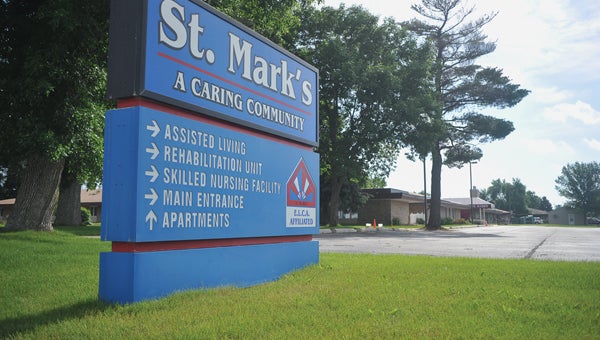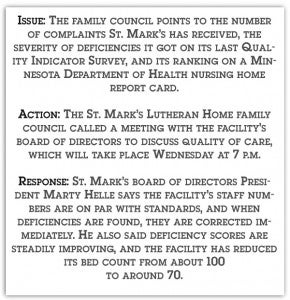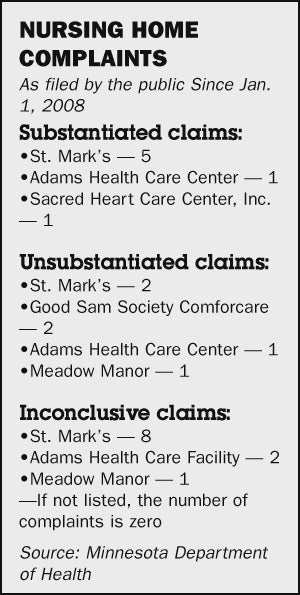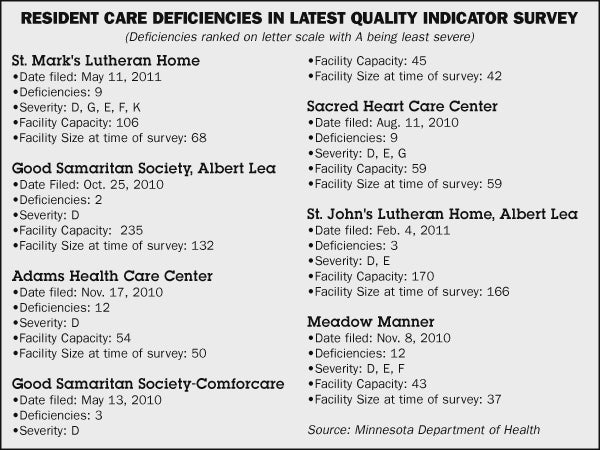St. Mark’s quality concerns
Published 11:20 am Tuesday, June 28, 2011

The St. Mark’s Lutheran Home Family Council will host a meeting 7 p.m. Wednesday in the St. Mark’s living room to address concerns about the level of care at the facility. -- Eric Johnson/photodesk@austindailyherald.com
State reports fuel worries about St. Mark’s quality, cost compared to other nursing homes in region
 State reports have led many to question the quality of care at St. Mark’s Lutheran Home and now have the center’s family council looking for ways to work toward improvements with the facility’s board of directors.
State reports have led many to question the quality of care at St. Mark’s Lutheran Home and now have the center’s family council looking for ways to work toward improvements with the facility’s board of directors.
“Public records indicate that St. Mark’s Lutheran Home ranks very low in areas of care given, while being higher in cost than other facilities in Minnesota,” family council President Dick Heuton wrote in an e-mailed response to the Herald.
The family council, an organization of residents’ family and friends, has invited the board of directors to a meeting in the St. Mark’s living room Wednesday at 7 p.m. to discuss concerns stemming from personal accounts and findings in multiple reports from the Minnesota Department of Health (MDH).
“We are very hopeful that positive changes can be made at St. Mark’s,” wrote family council member Jennie Saaranen in an e-mail. “The direct care and support staff there are remarkably kind, caring and diligent people. Many of the workers have years of experience in skilled care nursing facilities. We hope this meeting will bring the necessary awareness to facilitate those changes.”
Reports
To family council members and other concerned citizens, the need for change stems from MDH documents like a May 11 Quality Indicator Survey. Understaffing is one of nine deficiencies reported in the survey, and one that sticks out to Barbara Finley-Shea, pastor of Our Saviors Lutheran Church in Lyle.
 “A huge issue is understaffing, and the staff people have expressed concern that there are too few nursing assistants spread too thin,” said Finley-Shea, who has been researching reports and stories concerning St. Mark’s for about six years, though she’s not a member of the family council. “They are chronically understaffing direct care workers.”
“A huge issue is understaffing, and the staff people have expressed concern that there are too few nursing assistants spread too thin,” said Finley-Shea, who has been researching reports and stories concerning St. Mark’s for about six years, though she’s not a member of the family council. “They are chronically understaffing direct care workers.”
That’s not how board of directors President Marty Helle sees it. He said St. Mark’s staff numbers are on par with standards and numbers at other facilities.
“Staffing is always a huge concern because we have to staff this building 24-hours-a-day,” Helle said.
When deficiencies are found, Helle said the facility takes steps to correct them immediately, especially since unchecked deficiencies could result in fines or a freeze in new Medicare funding.
“We never take those things lightly,” he said. “They’re very, very important for this industry.”
That may not be enough to ease worries about St. Mark’s, as many of the home’s employees have voiced concerns about the care and staffing levels at the home, according to Finley-Shea.
“It’s many employees that are raising the flags that things aren’t going well here,” she said. “If they didn’t care about their job, they wouldn’t do that.”
While employees are calling for change, Finley-Shea said the administration and St. Mark’s management company, Ecumen, have not heeded the call.
“The administration does not want hear it,” she said.
Helle said he and St. Mark’s leadership welcomes criticism and concerns as a way to help St. Mark’s looks to improve.
“We have to be held to a high standard; we’re dealing with people’s lives here,” Helle said.
The Wednesday meeting is intended to help St. Mark’s achieve the best possible care.
“The family council will present information detailing concerns to the board of directors, seeking a positive reaction in the areas of improved care at reasonable costs,” Heuton wrote in an e-mailed response to the Herald.
Deficiencies
Though St. Mark’s was cited for nine deficiencies, Helle said scores at St. Mark’s are steadily improving.
“We had some surveys that were pretty bad several years ago,” he said. “We’re seeing a generally better survey,” he added, even though 2011’s survey was a slight decline from 2010. A 100 percent score on a state survey is a rare and likely impossible accomplishment, according to Helle.
“I doubt anyone ever gets a perfect survey,” he said.
State reports would back that up. Sacred Heart Care Center in Austin also had nine deficiencies in an Aug. 11, 2010, report, and Adams Health Care Center had 12 in a Nov. 17, 2010 survey.
While the number of deficiencies may be down, Finley-Shea and others argue the severity of claims has increased.
The most severe deficiency from this spring, according to MDH rankings, found that St. Mark’s failed to ensure unpasteurized eggs were cooked to safe temperatures to reduce the risk of food-borne illnesses.
Investigators found runny, unpasteurized eggs served to residents. Brown and black debris was found in six roasting pans, and the survey said “the facility failed to ensure sanitary practices were followed during the meals and used soiled pans for food cooking.”
Helle said no residents were harmed by eating the unpasteurized eggs. To correct the deficiency, St. Mark’s changed to serving all pasteurized eggs. Had St. Mark’s not addressed the issues, it would have resulted in a $4,500 fine.
St. Mark’s received another deficiency after a male resident developed pressure sores when staff did not move him every two hours as his care plan stipulated, according to the report. The resident at times went five hours without being moved.
Two nursing assistants told the MDH investigator a stage two pressure ulcer was caused by a machine that lifted the patient out of a wheel chair to use the bathroom. One nursing assistant told the interviewer, “I don’t know what the day shift does, but our normal routine is to get (the resident) up between 2:30 p.m. and 3 p.m. and back to bed at 7 p.m.,” according to the Quality Indicator Survey.
Had St. Mark’s failed to correct the deficiencies, the facility would have faced multiple penalties, including $1,500 and $4,500 civil penalties, and the home would have had to automatically deny new Medicaid and Medicare contracts, according to a survey.
MDH found St. Mark’s corrected the deficiencies in a timely manner, so the penalties were dropped.
Helle said promises of fines are common, but are rarely followed through on, because facilities correct the concerns.
The Quality Indicator Survey wasn’t the only MDH document to cause concerns about St. Mark’s. A MDH nursing home report card gave St. Mark’s two out of five stars for “resident quality of life ratings,” compared to a three star state average. St. Mark’s also received two stars for “state inspection results,” compared to a four and half star state average. However, St. Mark’s was on par with state averages for “quality of life indicators” and “hours of direct care” with three stars. The nursing home surpassed averages for “temporary staffing agency use” and “proportion of single rooms.”
Helle said the ratings aren’t all-encompassing because certain deficiencies automatically bring ratings like “resident quality of life” down to two stars.
Complaints
The state also traces complaints filed against a nursing home. Since January of 2008, five complaints that were found to be substantiated were filed against St. Mark’s. No other nursing home in Mower County has had more than one during that period. Another eight inconclusive complaints were filed concerning St. Mark’s. Two inconclusive claims have been filed against Adam’s Health Care Center, the only other facility with more than one in the county.
MDH officials investigate complaints, but little happens at the state level even if maltreatment occurred, because the Vulnerable Adult Act doesn’t stipulate any penalties for maltreatment, according to Stella French, director of the office of health facility complaints.
But complaints aren’t a perfect indicator.
“Anyone can call in a complaint, and it doesn’t even have to be true,” she said. “Our focus is on the vulnerable adult.”
It’s not surprising to Helle that St. Mark’s has more complaints because it’s bigger than other facilities in the area.
“I think we stack up pretty well compared to other facilities of our size,” he said.
Past and future
Concerns about care at St. Mark’s and Ecumen date back about six years, according to family council officials. At the 2010 annual meeting, congregational representatives from the area Lutheran churches that oversee St. Mark’s voted 38-12 in favor of removing Ecumen.
However, Helle said the board has no plans to remove it. Only the board can make such a decision, so the vote served as an advisement.
But worries about care haven’t always been the norm at St. Mark’s, according to Finley-Shea, who said the facility used to be a premier home.
“It was the best place for care. People were well cared for,” she said.
St. Mark’s will soon begin a building project to add more assisted living rooms while reducing the number of nursing home beds. The move will also decrease the number of St. Mark’s care workers. At the same time, the number of long-term care residents has decreased from around 100 to about 70.
Though overall staff numbers are decreasing, Helle said the ratio of care workers to long-term residents is still sufficient.
Helle said the new addition and the subsequent assisted living rooms are needed in Austin. Though Helle said St. Mark’s can provide high-quality care now, he said the new facility will add new technology to the home.
“It’s going to be a very high-tech, state of the art facility,” he said.





